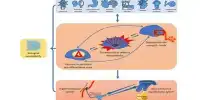Cycling can help you avoid dangerous diseases like stroke, heart attack, certain malignancies, depression, diabetes, obesity, and arthritis. Riding a bike is a low-impact, healthy form of exercise for people of all ages. Cycling to the store, park, school, or job is a simple way to incorporate it into your daily routine.
Patients who participated in the trial saw a 1.6-kilogram gain in muscle mass and a 2% reduction in body fat. When researchers examined them at the end of the 12-week trial, they were also able to walk an additional 47 meters in six minutes. The study included eleven patients.
According to a study performed by McMaster University researchers, frequent cycling can significantly enhance mobility in patients with myotonic dystrophy (MD), a hereditary illness that causes muscle atrophy. Cycling for 35 minutes three times a week for 12 weeks, according to senior author Mark Tarnopolsky, resulted in a 32% increase in overall fitness in patients with MD.
Patients who participated in the trial also reported a 1.6-kilogram gain in muscle mass and a 2% reduction in body fat. When researchers examined them at the end of the 12-week trial, they were also able to walk an additional 47 metres in six minutes.
Exercise truly is medicine; we just need to get the message out. Myotonic dystrophy is a progressive condition that limits mobility and may need you to use a wheelchair. There is no cure, and only regular exercise will help you operate better.
Mark Tarnopolsky
Tarnopolsky’s team enlisted the help of 11 MD patients to see how successful cycling was at restoring and maintaining their physical health. The researchers also investigated the molecular mechanisms through which exercise strengthens skeletal muscles, which can be severely compromised by MD.
Cycling is an excellent technique to regulate or lose weight since it increases your metabolic rate, builds muscle, and burns body fat. Cycling must be linked with a healthy food plan if you want to reduce weight. Cycling is a relaxing kind of exercise that allows you to vary the time and intensity – it can be gradually increased and varied to suit you.
According to research, you should burn at least 8,400 kilojoules (approximately 2,000 calories) every week through exercise. Cycling for an hour burns roughly 1,200 kilojoules (about 300 calories). When you cycle twice a day, the kilojoules you expend quickly pile up. According to British studies, a half-hour bike ride every day will burn roughly five kilograms of fat over the course of a year.
“Exercise truly is medicine; we just need to get the message out,” said Tarnopolsky, a McMaster professor of pediatrics and medicine. “Myotonic dystrophy is a progressive condition that limits mobility and may need you to use a wheelchair. There is no cure, and only regular exercise will help you operate better.”

According to Tarnopolsky, some MD patients are even urged by their doctors not to exercise for fear of aggravating their illness, but this has recently been shown wrong. According to the study’s authors, earlier research on mice models shown a variety of physiological benefits from regular exercise. According to Tarnopolsky, MD is the most commonly diagnosed type of muscular dystrophy in adults and the second most common of all muscular dystrophies.
Stroke, high blood pressure, and heart attack are all examples of cardiovascular illnesses. Cycling on a regular basis strengthens and improves your heart, lungs, and circulation, lowering your risk of cardiovascular disease.
Cycling helps to strengthen your cardiac muscles, lowers your resting pulse, and lowers your blood fat levels. According to research, those who ride to work are exposed to two to three times less pollution than those who drive, hence their lung function improves. A 14-year Danish study of 30,000 persons aged 20 to 93 years discovered that regular cycling protected people from heart disease.
The most common signs of MD include severe skeletal muscular atrophy, overall muscle weakness, decreased lung capacity, and poor heart function. Cataracts, endocrine diseases such as diabetes, and gastro-intestinal issues are also possible signs. According to Tarnopolsky, around 19,000 Canadians have MD or another type of muscular dystrophy.
“MD is actually a sort of accelerated aging,” Tarnopolsky explained. The study was recently published in The Journal of Clinical Investigation. The Canadian Institutes of Health Research provided external support for this study.
















